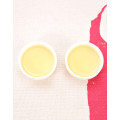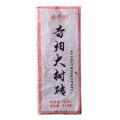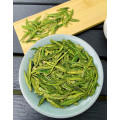Choosing the right tea can be a daunting task, especially for tea novices. With so many different tea origins and names, even experts may struggle to remember or be familiar with all of them. For beginners, the lack of tea-related knowledge can make it even more challenging. However, there are a few key tips that can help you navigate this vast world of tea and find the perfect one for yourself.
First and foremost, it's important to consider your personal taste preferences. Everyone has different taste preferences when it comes to tea. Some people enjoy strong, robust teas, while others prefer delicate and subtle flavors. Some teas may have a bitter taste, while others may be slightly sweet or refreshing. Choosing a tea that suits your taste will ensure a pleasant drinking experience.

Chinese Black Tea Displayed On a Tea Stall
Age also plays a role in selecting the right tea. Younger people tend to enjoy teas with lower fermentation levels, such as green tea or white tea. On the other hand, older individuals may benefit from teas with higher fermentation levels or warm-natured teas that are gentle on the stomach.
Considering your own body constitution is also important when choosing tea. For example, if you have a yang deficiency, characterized by cold hands and feet, you may benefit from warming teas. On the other hand, if you have a yin deficiency, with symptoms like hot hands and feet and dry mouth, you may prefer cooling teas.
Budget is another factor to consider when buying tea. Not all expensive teas are necessarily the right ones for you. It's important to assess your own financial situation and not feel pressured to buy expensive teas if it's not within your means. Remember, the enjoyment of tea should not be about comparison or showing off.

Observe The Appearance Of Tea Before Purchasing
Now, let's discuss some basic techniques for selecting tea:
Step 1: Examine the appearance
The first step in selecting tea is to observe its appearance and shape. Teas with similar prices usually have similar appearances. For example, in the case of black tea, finer leaves tend to be more tender and have more tea buds, resulting in a better taste. Look for tightly rolled tea leaves without too many coarse stems or large leaves.
Step 2: Smell the aroma
The aroma of tea comes from its aromatic compounds, which are easily influenced by temperature. You can stimulate the release of tea aroma by using warm water. Smell the dry tea leaves to assess the fragrance and whether there are any unpleasant odors. Then, ask the seller to brew a cup of tea and smell the aroma that rises from the cup. Each tea may have a slightly different aroma, but it should be pure and not overpowering or unpleasant. Choose the aroma that appeals to you and aligns with the characteristics of the tea you want to buy.
Step 3: Taste the tea
Tasting the tea is the final step for regular consumers, while professionals may also examine the tea leaves. After observing the color of the tea soup, taste it by taking consecutive sips and assess its flavor profile. Good tea should have a smooth texture that glides down the throat. It should leave a pleasant aftertaste and make you want to have another cup. Pay attention to the fragrance, bitterness, and astringency of the tea as well.
Additionally, the ability of tea leaves to withstand multiple infusions can also indicate their quality. For example, green tea should still have a good taste after three infusions, while some high-quality teas can be steeped up to ten times or more.
Step 4: Talk to the seller
When buying tea, don't be afraid to engage in conversation with the seller. Even if you're a novice and don't know much about tea, asking questions about the tea's origin, processing, and storage can help you gauge the seller's knowledge and expertise. This interaction can also enhance your understanding of tea and aid in making informed decisions. If you're unsure about tea, even chatting about topics unrelated to tea can give you valuable insights and help you make better choices. Remember, as a beginner, it's important to ask questions because it's the most reliable way to learn. If you don't ask, you may be easily misled.
In summary, selecting tea involves observing its appearance, smelling its aroma, tasting the tea soup, and engaging in conversation with the seller. By following these steps, you can gain a thorough understanding of a particular tea's characteristics. For experienced tea enthusiasts, further examination, such as inspecting the tea leaves, may be necessary for a detailed assessment.

Some Tea Stalls In a Large Chinese Tea Market
Let me explain the basic knowledge of tea to you in more detail. I hope it will be helpful.
In general:
Chinese tea is classified into six main categories: green tea, white tea, yellow tea, oolong tea, black tea, and dark tea.
The classification of these teas is determined by the degree of fermentation, with green tea having the shortest fermentation time and black tea having the longest fermentation time.
The nature of tea also varies from cold to warm. (The nature of tea refers to the taste and characteristics exhibited by the tea leaves. You can choose tea according to your own physical condition, which is why there are different ways to drink tea for different people and different occasions.)
In addition to the above, each type of tea has different taste characteristics due to the varying degrees of fermentation.
Green tea is refreshing, white tea is sweet, yellow tea is mellow, oolong tea is fragrant, black tea is rich, and dark tea is smooth. You can understand it this way: green, white, yellow, oolong, black - the earlier ones are refreshing, while the later ones are rich. The overall taste revolves around freshness, sweetness, richness, thickness, intensity, and freshness.
Therefore, based on the characteristics of tea, you can easily find the tea you enjoy drinking.
Besides these, different types of tea also produce different fragrance profiles due to factors such as variety, cultivation conditions, picking quality, and tea-making techniques.
Green tea and yellow tea are known for their tender and fresh fragrances, while white is known for its bud fragrance. Oolong tea combines floral and fruity fragrances with a hint of smokiness, red tea has a sweet fragrance, and black tea has a mellow fragrance.

Two Tea Enthusiasts Are Examining The Tea Leaves
Before purchasing tea, you can taste some samples to see which one suits your taste.
Therefore, when drinking tea, you can also judge the quality of the tea based on its aroma.
Taking a closer look:
Different varieties of tea are further divided into different types based on different production methods.
For example, green tea is divided into five types based on different methods of fixation and drying:
Pan-fried green tea (such as Longjing tea), roasted green tea (such as Tai Ping Hou Kui Green Tea), combined roasted green tea (such as Meng Ding Gan Lu), sun-dried green tea (such as Dianqing Maocha), and steamed green tea (such as Enshi Yulu).
White tea is categorized based on different tea tree varieties and the standard for picking leaves at different times. Some well-known varieties include Bai Hao Yin Zhen, Bai Mu dan, and Tribute Eyebrow, mainly produced in Fujian Province, China.
The differentiation of yellow tea is based on the maturity level of fresh leaves, including Mengding Yellow Bud Tea, Yellow Xiaocha, and Yellow Dacha.
Oolong tea, also known as Chinese Qincha, is divided based on the production region, such as Northern Fujian Oolong (such as Da Hong Pao), Southern Fujian Oolong (such as Anxi Tie Guanyin), Guangdong Oolong (such as Fenghuang Dancong), and Taiwan Oolong (such as Dongfang Meiren).
Black tea is divided into different types based on different production methods, including Gongfu Black Tea (such as Qi Hong Jin Zhen), Lapsang Souchong (such as Zhengshan Xiaozhong), and Broken Black Tea (such as Nanchuan Hongsuicha).
Finally, dark tea is classified based on the region, including Hunan Dark Tea (such as Sanyan), Northwest Old Green Tea Cake (such as Qingzhuan Tea), Guangxi Liu Bao Tea, ripe Pu-erh Tea, and Shaanxi Fucha (such as Jingyang Fuzhuancha).





Leave your comment